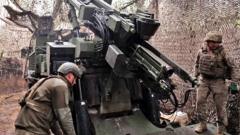In the eastern region of Ukraine, the air is thick with intensity as soldiers from the 155th mechanised brigade actively engage in the defense of Pokrovsk, a crucial transport hub. The footage from drones captures the stark reality of the war, showcasing the ruins left in its wake. The scale of destruction is alarming, with recent months revealing greater devastation than ever witnessed before.
In this climate, optimism surrounding negotiations has emerged, particularly after Russia expressed interest in talks for the first time in three years. Soldiers like Kozak, who has witnessed the unrelenting cost of the conflict, believe that constructive dialogue could signal a shift toward peace. “I want to believe this could mark the beginning of the end of the war,” he states, despite the years of dashed hopes.
Yurii, a former technology worker turned soldier, echoes the sentiment but stresses the importance of acknowledging the war's roots. He reflects on the necessity of communication to foster peace while maintaining a defensive stance against giving up territory—concerns informed by the reality that yielding land could open the door for future aggression.
The advancement of warfare technology presents another layer of danger, especially with the rise of drone usage. Ukrainian forces adapt continuously while relying on international assistance for critical artillery support, such as the French-made Caesar artillery guns, known for their precision.
As the battle intensifies, anxieties about the notion of ceding land for peace become palpable. Many soldiers fear that any concessions will not lead to lasting security but instead embolden further conflict. The desire to protect their homeland is paramount, reflecting the sacrifices made and the memories of comrades lost.
Among those who feel the war's impact is Yana Stepanenko, a grieving mother who visits her son’s grave, a stark reminder of the human cost behind the ongoing confrontation. Her hopes for peace are shadowed by disbelief in the sincerity of negotiations, driven by the experiences of conflict's cruelties.
Despite the reluctance to surrender territory, both soldiers and civilians unite in the longing for peace, striving for a resolution that will honor the lives lost and restore their homeland. The future remains uncertain as Ukraine stands resilient on its front lines, bold yet weary, echoing the need for steadfast support and understanding from the global community.
The narrative of enduring hope amidst a bleak reality continues to shape the discourse around peace talks, with the collective heart of Ukraine bound to its sovereignty and the longing for a resolution free from the grip of aggressors.
In this climate, optimism surrounding negotiations has emerged, particularly after Russia expressed interest in talks for the first time in three years. Soldiers like Kozak, who has witnessed the unrelenting cost of the conflict, believe that constructive dialogue could signal a shift toward peace. “I want to believe this could mark the beginning of the end of the war,” he states, despite the years of dashed hopes.
Yurii, a former technology worker turned soldier, echoes the sentiment but stresses the importance of acknowledging the war's roots. He reflects on the necessity of communication to foster peace while maintaining a defensive stance against giving up territory—concerns informed by the reality that yielding land could open the door for future aggression.
The advancement of warfare technology presents another layer of danger, especially with the rise of drone usage. Ukrainian forces adapt continuously while relying on international assistance for critical artillery support, such as the French-made Caesar artillery guns, known for their precision.
As the battle intensifies, anxieties about the notion of ceding land for peace become palpable. Many soldiers fear that any concessions will not lead to lasting security but instead embolden further conflict. The desire to protect their homeland is paramount, reflecting the sacrifices made and the memories of comrades lost.
Among those who feel the war's impact is Yana Stepanenko, a grieving mother who visits her son’s grave, a stark reminder of the human cost behind the ongoing confrontation. Her hopes for peace are shadowed by disbelief in the sincerity of negotiations, driven by the experiences of conflict's cruelties.
Despite the reluctance to surrender territory, both soldiers and civilians unite in the longing for peace, striving for a resolution that will honor the lives lost and restore their homeland. The future remains uncertain as Ukraine stands resilient on its front lines, bold yet weary, echoing the need for steadfast support and understanding from the global community.
The narrative of enduring hope amidst a bleak reality continues to shape the discourse around peace talks, with the collective heart of Ukraine bound to its sovereignty and the longing for a resolution free from the grip of aggressors.




















